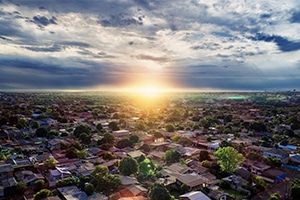Please fill out the details below to receive information on Blue Wealth Events
"*" indicates required fields

As we’ve entered into the third quarter of 2018, we’re taking a look at how each market has fared throughout the first half of 2018.
Sydney
After much anticipation, Sydney’s booming market has come to a holt. Between 2011 and 2017 Sydney’s property market has outperformed the nation. The cooling of Sydney’s market has occurred as a result of a number of factors:
ABS data indicates in that in December Quarter of 2017, Sydney’s median house price was $1,031,000. In the March quarter of 2018, median prices dropped to $905,000. This equates to a 12.2% reduction.
Melbourne
Over the past few years, Melbourne has experienced strong price growth in median house prices, with many suburbs matching the growth of Sydney. In 2018, the market has slightly cooled however, not to the extent of Sydney’s. In the December 2017 Quarter Melbourne median house price was recorded at $760,000, in March 2018 ABS found the median house price has reduced to $722,000. The slowdown of Melbourne’s property market is likely to be short-lived. The strength of population and economic growth hold Melbourne in good stead for the future.
The disparity between house and apartment prices continues to expose a unique opportunity in Melbourne. In some Blue Wealth approved areas this gap is wider than its ever been.
Hobart
An unexpected bolter, who’s taken the mantle as Australia’s top performing capital city continues to bat well-above its weight, particularly from a yield perspective. Hobart offers returns of over 6% on relatively cheap apartments. Of course, our job is to identify areas at a phase of opportunity that present specific growth drivers rather than those excelling on the back of short-term sentiment. Hobart’s unpredictable upswing is a result of low supply and relative affordability rather than the traditional drivers which have seen markets perform strongly.
Between the December 2017 quarter and March 2018 quarter Hobart again experienced 4.5% growth in median house prices.
Adelaide
Affordability remains the only real driver for price growth. The reality is that while Adelaide remains a weak economy, the lack of employment growth will limit potential population growth and property demand, extending the markets stagnation. Interstate migration remains a concern with declining figures year on year. In 2017, Adelaide lost over 6,900 residents to other states.
The market has remained quite stagnant, between the December and March quarters, median prices in December were recorded at $469,000 and in March at $465,000.
Markets are constantly fluctuating, when you’re investing for the long term it’s important to ensure that the market you are investing in presents the long term sustainable growth drivers which are likely to remain constant throughout the holding period. In next weeks insight we’ll discuss the remaining capital city markets and provide an update on their performance in the early parts of 2018.
